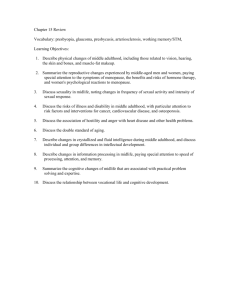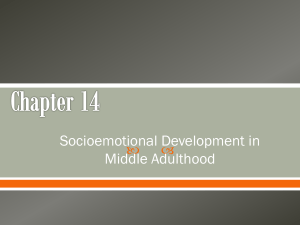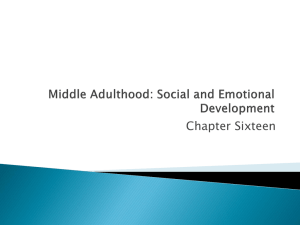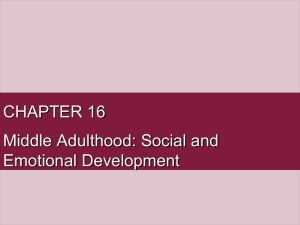Document
advertisement
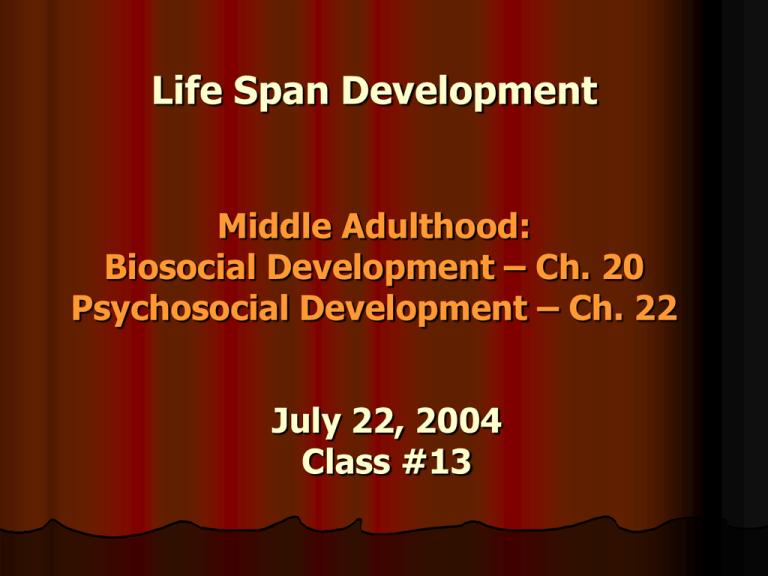
Life Span Development Middle Adulthood: Biosocial Development – Ch. 20 Psychosocial Development – Ch. 22 July 22, 2004 Class #13 Middle Adulthood Biosocial development halfway between beginning and end of adulthood Variations in aging, influenced by genes income ethnicity life style Primary and Secondary Aging Primary aging—inevitable age-related changes Secondary aging—age-related changes that are the consequence of a person’s behavior or society’s failure to eliminate unhealthy conditions drinking smoking eating lack of exercise Looking Old Hair turns gray and thins Wrinkles appear and skin becomes dry Body size (people get shorter) and shape change (fat pockets settle on various parts of body) As people age, they can either accept or try to change their appearance The Senses Vision more likely to need corrective lenses Hearing some hear much better than others none hear perfectly hearing acuity also differs by sex, with men suffering greater loss Vital Body Systems Systematic declines make people more vulnerable to disease Flu shot recommended for middleaged people who have had illness or medical condition that depletes organ reserve U.S. death rate during period of middle age has been cut in half The Sexual-Reproductive System Changes occur in the sexual reproductive system during middle age sexual responses slower reproduction less likely Menopause Occurs between ages 42 and 58 marked decrease in the production of estrogen, progesterone, and testosterone primary factors in exact age are genes and chance factors before birth can also occur earlier because of health habits, particularly cigarette smoking and malnutrition Menopause Perimenopause, or Climacteric extends from 3 years before to 3 years after cessation of menstrual cycle timing of periods is erratic unpredictable ovulation, with several ova released sometimes, and at other times none can result in “change of life” baby Menopause Symptoms of the Climacteric lower estrogen, osteoporosis, inability to reproduce hot flushes, hot flashes, cold sweats (vasomotor instability) mood changes for some women psychic consequences extremely variable Hormonal Replacement Therapy HRT treatment to compensate for hormone reduction usually involves estrogen and progesterone Hormonal Replacement Therapy Women’s Health Initiative revealed long-term use (10 years or longer) of HRT increases risk of heart disease stroke breast cancer Osteoporosis Male Menopause? Do men undergo menopause? Males decline in sperm production and motility, as well as lower testosterone levels No dramatic andropause though men can suffer from sudden, stressrelated shifts in hormone levels the opposite can also occur: a rise in selfesteem Male Menopause? Even with the help of new drugs, like Viagra, most men will experience a decline in sexual desire and speed of intercourse as they age Worry about aging bodies and life changes can magnify the sexual consequences of aging Measuring Health 4 Measures of Health death, disease, disability, and vitality Mortality and Morbidity Mortality—the number of deaths each year per 1,000 people in a given population Morbidity—the rate of diseases of all kinds, chronic and acute, in a given population Disability and Vitality Disability inability to perform activities that most others can more costly to society than either mortality or morbidity Vitality how healthy and energetic one is— physically, socially, and emotionally The Burden of Poor Health Quality-Adjusted Life Years (QALYS) years of full vitality useful in evaluation of the costs and benefits of various medical interventions for example, clean water, immunizations, and adequate nutrition all improve quality and length of life The Burden of Poor Health Disability-adjusted life years (DALYS) each year lost to premature death and each fraction of full quality of life due to disability reduces a person’s DALYS Burden of disease—total reduction in vitality caused by a disease-induced disability in a given population. An example would be obesity of Americans. Health Habits Over The Years Health habits are relevant through all of life, but most crucial during 35-65 for reassessment and improvement many middleagers improve their health habits individual and environmental variations can affect who gets healthier—choices are crucial Tobacco More than 1/4 of middle age nonsmokers are former smokers 1/4 currently smoke Quitting by age 65 is too late for some smokers death rates are about the same as they have been in the past Tobacco Smoking increases rate of most other serious diseases including cancer of the bladder, kidney, mouth, stomach heart disease stroke pneumonia emphysema All smoking diseases are dose- and duration-sensitive Tobacco Secondhand smoke is dangerous Worldwide tobacco use is expected to cause more deaths in 2020 than any other single condition Smoking influenced by social norms Alcohol Adults who consume alcohol in moderation (nor more than two servings a day) tend to live longer than those who never drink helps reduce heart disease More alcohol consumption comes with notable risk Alcohol Alcohol is a depressant yet we often feel lively after a couple of drinks… It gives this feeling by slowing down the brain centers that control judgments and inhibitions Curious Effects Memory Sex Hangover Alcoholism Refers to one’s dependence on alcohol that seriously interferes with one’s life Most common and costly form of drug abuse in U.S. Aproximately 7% of adults 18 and over (10M people) Traditionally more common (about 2 to 1) among males but recent research suggests that women are closing this gap Detrimental Effects Life span of average alcoholic is 12 years shorter than the norm Alcoholism ranks as the third leading cause of death in U.S. More than one-third suffer at least one coexisting mental disorder Organic impairment such as brain shrinkage occurs in a high proportion of alcoholics About 20% attempt suicide About 10% are successful Detrimental Effects Associated with about half of deaths and major injuries suffered in motor vehicle accidents Associated with about half of all murders Associated with about one-third of all assaults and rapes Associated with about one-third of all arrests Alcohol-related accidents are the leading cause of death among college-aged individuals Symptoms of Alcohol Dependence Use alcohol to boost self-confidence and to relax around others Drink to forget their problems or to relieve stress Often are the ones who want “one more” drink even when their friends have stopped drinking After friends have left they drink with new friends…often close the bar…stay past last call Get drunk without planning to Have blackouts Symptoms of Alcohol Dependence Lie about their drinking, try to hide it, sneak drinks at work or school Drink in the morning to cure a hangover May begin to have financial, work, or family problems Complete loss of control Treatments Rehab Centers Alcoholics Anonymous Treatment centers where the addict is supervised 24/7 Supervised detoxification period to eliminate drugs from our bodies system Self-help group Little research because of members anonymity but indications are most don’t stick to it Need to go to regular meetings for it to work 90 meetings in first 90 days and then at least once per week after that Antabuse A type of aversion therapy where usually a pill is taken that will cause the patient to become sick whenever they drink alcohol Obesity and Overweight According to the World Health Organization,there is a worldwide epidemic of obesity and overweight Excess pounds cut down 3 years of life 65 percent of U.S. population between 35 and 65 years of age are overweight increased significantly for both sexes, in every decade in every cohort in every ethnic group Obesity and Overweight In almost every nation, people weigh more than they did a few decades ago Being overweight increases risk of every cause of disease, as well as of disability and death Losing Weight 3 factors make weight loss difficult environmental factors more easily alterable than evolutionary or genetic causes evolution homeostastis makes people who lose weight crave food to protect against starvation genes, which regulate metabolism fat accumulation Exercise Needed to attain and maintain a healthy weight Burns calories, decreases appetite, and increases metabolism Reduces ratio of body fat to body weight Enhances cognitive functioning Ethnic Variations and Health Women outlive men in every nation of the world Well educated, financially secure people live longer than people of same age, sex, and ethnicity with less education and money income and education lead to access to services People in cities live longer than do people in the countryside The Influence of Ethnicity on Health Some immigrants are healthier than long-time residents of same age and ethnicity because only hardiest individuals emigrate health habits of immigrants are better immigrants have optimistic outlook immigrants have family communication and support Three Causes of Ethnic Variations in Health Genetic risks Specific health care behaviors Social context factors including stress, prejudice, and poverty Genetic Risks Each individual has particular genetic risks to be aware of family history can make some risks apparent medical tests sometimes confirm genetic influences but genes act epigenetically—that is, genes and lifestyle interact Doctors and Patients Health Care System in United States, works less well for minorities and for the poor minorities and the poor less likely to seek preventive care when they do get care, it is less than it might be The Social Context People in poorer nations experience higher rates of almost every disease, injury, and cause of death Psychosocial Development – Ch. 22 Personality Throughout Adulthood Personality continuity provides is a major source of coherence and identity The Big Five Several researchers have found evidence for the existence of five basic dimensions of personality through factor analysis 5 factors are independent of one another Everyone can be placed along a continuum for all 5 factors/traits The Big Five Extraversion Agreeableness Conscientiousness Emotionality (also referred to as Neuroticism) Intellect (also referred to as Openness) What researchers say… From a review of literature the following are some of the important characteristics of the five factors: The factors are dimensions, not types, so people vary continuously on them, with most people falling in between the extremes The factors are stable over a 45-year period beginning in young adulthood The factors and their specific facets appear heritable The factors are considered universal Knowing one's placement on the factors is useful for insight and improvement through therapy What Are These Five Factors? Extraversion Agreeableness Bold versus timid Outgoing versus introverted Talkative versus silent Friendliness versus indifference to others A docile versus hostile nature Compliance versus hostile noncompliance Conscientiousness Responsible versus irresponsible Hardworking versus lazy Cautious versus rash What Are These Five Factors? Neuroticism Adjustment versus anxiety Level of Emotional stability Dependence vs. independence Openness Reflection of an inquiring intellect Flexibility versus conformity Rebelliousness versus Subduedness Developmental Changes in Personality Environment generally reinforces basic temperament significant changes can make people act differently death etc. of a spouse, divorce, illness, career change, Gender Convergence Gender convergence—a tendency for men and women to become more similar as they move through middle age Gender crossover—the idea that each sex takes on the other sex’s roles and traits in later life. Gender Convergence These ideas are partly biosocial, “shadow side,” and cultural Barnett and Hyde (2001) believe that this change is historically-based the past century witnessed changes every decade and gender roles changed today’ middle-aged generation is probably less likely to converge since male-female differences in personality less apparent The “Midlife Crisis” A period of unusual anxiety, radical reexamination, and sudden transformation widely associated with middle age, but probably more related to developmental history than to chronological age The “Midlife Crisis” The idea was promoted by Sheehy (1976) and Levinson (1978), but no large study has found such a crisis Why then do people talk about it as if it really existed? myth may allow adults to cope with disappointment, frustration, sadness caused by aged-related changes Family Relationships in Midlife Family is most important support system If one’s own family is not doing that job, “fictive kin” may be found treated as family by this group Social convoy—group of people who form relationships with an individual through which they guide and socialize that person as he or she moves through life Partners Having an intimate relationship is a source of happiness, comfort, and self-respect; for 70 percent of middle-aged Americans, this achieved with a spouse For some divorced, widowed, or nevermarried middle-aged adults, intimacy may be achieved by cohabitation Marital Happiness Not all people are in good/happy relationships relationship may be destructive but worldwide, spouse abuse far more common among younger married couples than among middle-aged spouses Marital Happiness Often regain some of closeness of early marriage less stress from kids higher incomes more time together Studies in various cultures show that marital happiness in midlife is true In general, marriage relationships likely to get better over time Divorce and Remarriage Not all couples become closer after years of marriage, divorce has more impact reduces income, weakens family ties when longterms social bonds especially needed Most divorced remarry within 5 years Remarriage offers benefits to both men and women Second marriages end in divorce more often than first marriages do The Marriage Market for Middle-Aged Adults Marriage is likely to benefit middleaged adults Middle-aged women are at a disadvantage for marrying, remarrying beginning at aged 45, there are more women than men men tend to marry younger women Other Relatives Kinkeeper—the person who takes primary responsibility for celebrating family achievements, gathering the family together, and keeping in touch with family members who live far away most likely to be middle-aged most are women, but men also can take the role Aging Parents Relationship with Parents improves with time Familism—the idea that family members support one another because family unity is more important than individual freedom and success stronger with ethnic minorities Siblings Siblings often become closer to each other in the second half of life than in early adulthood They help one another with problems with teenage children, stressful marriages, and family contacts Siblings Childhood Echoes—the relationship in middle and late adulthood is influenced by family values instilled in childhood closeness can also be affected by childhood rivalries, but these may be put aside at this point Adult Children Relationship with Children improves with maturity of children Seven-nation survey: 75 percent of middle- aged parents communicated with adult children several times a week Adult Children Forms of Parental Support monetary various services like babysitting Some children return home, referred to as “swollen nest” Young adult children less likely to leave home, especially if parents in good health and they themselves are financially needy Grandchildren Personality, ethnicity, national background, and past parent-child relationship affect nature of grandparent-grandchild relationship as does child’s age and personality Bond closer if grandchild young parent is first to have children grandparent neither too young nor too old to spend time/energy interacting Types of Grandparents Remote grandparents—respected and loved emotionally distant grandparents Involved grandparents—active in day to day life, live near, see often Companionate grandparents—independent, with own lifestyle and household, choose how generational interaction occurs Most grandparents want to be companions Immigrant Grandparents Happily become involved, especially when all speak a common language Often live in the same household Children seem to develop better when they are cherished and guided by a large family Surrogate Parents Surrogate parents—grandparents who take over the raising of their grandchildren as a result of their adult children’s extreme social problems if parents too poor, too young, drug or alcohol addicted, single, newly divorced, then— possibility of surrogate parenting increases Surrogate Parents Grandparents furnish stability, guidance, and patience Responsibility takes a toll if it lasts too long can impair health and well-being After Adult Children Divorce More than one in three grandparents witness divorce of an adult child Grandparents typically provide extra help when their newly divorced child receives custody of children If their adult child does not have custody, they may be shut out grandparents in such situations may sue for visitation rights Work in Middle Adulthood 90 percent of men and 75 percent of women in the United States are employed Worldwide, work is a welcome part of life Most jobs provide more joy than stress Overall Trends Meaningful work becomes more important as an individual ages salary and benefits tend to rise with seniority lower rates of absenteeism being fired or quitting seeking a new job Many middle aged workers have worked for the same employer for more than five years There may be unexpected job loss as a result of downsizing and restructuring or relocation of company Dealing with Job Stress Some people addicted to long hours and hard work, or “workaholism” Both men and women are physically and psychologically healthier if they have multiple roles Stress in one area of life can be relieved by support from other areas Scaling Back Begin to deliberately balance work life with other concerns Place limits on work hours or responsibilities One partner may work part-time or at a less critical and lower paying job Or partners may take turns; one focuses on employment, the other on child care Rethinking and shifting toward retirement Retirement Planning and actual event usually occur in middle age Retirement generally anticipated with more joy than dread The decision to retire is usually mutual, since both husband and wife are working Main planning consideration is financial



